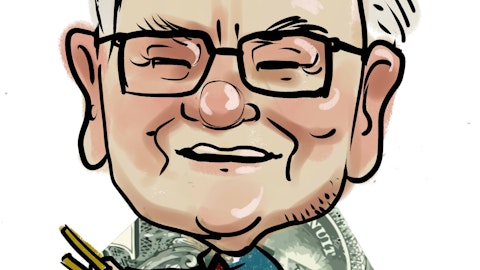One of the screens we use to pick stocks is Jim Cramer’s stock picks. Jim Cramer has a bad reputation because he makes thousands of recommendations on TV and investors tend to remember bad experiences, not the good ones. You wouldn’t believe this but there is an academic study that showed that Cramer’s stock picks actually beat the market by a significant margin. In this article we will take a closer look at five stocks that are in Cramer’s charitable trust’s portfolio and decide whether they are good investments for investors looking for large capital gains.

Apache Corp (APA): APA is the largest US energy stock in Cramer’s trust. As of February 15, 2012, the fund owns 1050 shares of APA, which worth about $113,000. APA is also quite popular among hedge funds. At the end of the third quarter, there were 30 hedge funds with APA positions. For example, Jean-Marie Eveillard’s First Eagle Investment Management had $147 million invested in APA. Ric Dillon and Boykin Curry were also bullish about the stock. Each of them had more than $100 million invested in APA at the end of September.
We agree with these hedge fund managers. In late January, APA announced that it agreed to acquire Cordillera Energy Partners III LLC for $2.85 billion. Cordillera has nearly 254,000 net acres in Anadarko Basin of Texas. It also has reserves of 71.5 million barrels of oil equivalent and its current net production is about 18,000 barrels per day. The acquisition will also provide APA with about 14,000 potential drilling locations. APA is already trading at attractive multiples. Its forward P/E ratio is 8.78 and its EPS is expected to grow at 11.22% on the average per year over the next five years. So its P/E ratio for 2014 is only 7.02. One of the comparable stocks is Anadarko Petroleum Corporation (APC). Anadarko’s market cap is almost the same as Apache’s market cap. However, APA’s P/E ratio is much lower than that of APC. Anadarko’s P/E ratio for 2014 is 14.3. We think Apache is a “buy” at these prices.
Schlumberger Limited (SLB): Cramer also had more than $100,000 invested in SLB. As of February 15, 2012, his charitable trust owns 1300 shares of SLB, which are worth about $100,724. SLB is also quite popular among hedge funds. At the end of September last year, there were 42 hedge funds with SLB positions in their 13F portfolios. For instance, Ken Fisher was the most bullish hedge fund manager about SLB. Fisher Asset Management had nearly $500 million invested in SLB at the end of the third quarter. Jim Simons’ Renaissance Technologies also invested nearly $200 million in this stock. Schlumberger has reasonable debt levels, growing net income and revenue, and healthy cash flow from operations. It is relatively expensive compared with its competitors though. SLB has a forward P/E ratio of 13.6. Its expected annual EPS growth rate is 21.82% on the average for the next five years, which means that its P/E ratio for 2014 will be around 9.2. This is quite low compared with the market, but not so versus its peers. We prefer Halliburton (HAL) to SLB because the former has an ultra-low forward P/E ratio of 7.79 and is also expected to grow its EPS by 27.99% per year in the next five years.
A few other energy stocks that Cramer likes include ConocoPhillips (COP), Energy Transfer Partners LP (ETP), and Kinder Morgan Energy Partners LP (KMP). Cramer invested relatively less in these three positions compared with APA and SLB. His trust owns about $50,000 worth of COP, $34,000 worth of ETP, and $27,000 worth of KMP. COP is quite popular among hedge funds, while ETP and KMP are not. At the end of September, there were 32 hedge funds with COP positions in their 13F portfolios. On the other hand, there were only 4 and 5 hedge funds respectively with ETP or KMP positions. We like COP as it has a low forward P/E ratio and it also has a decent dividend yield of 3.59%. Though hedge funds are not so bullish about ETP and KMP, they have high dividend yields of more than 5%. We don’t recommend these stocks if you are looking for large capital gains though.


